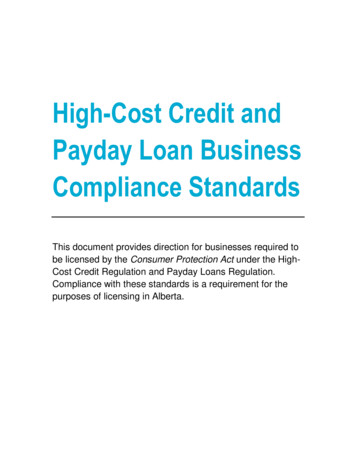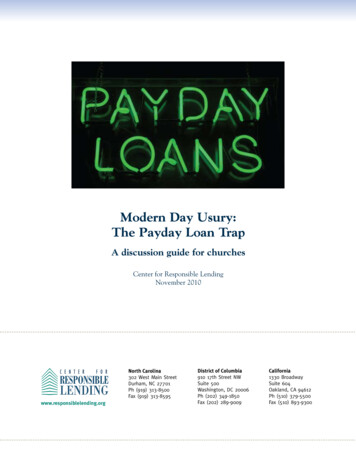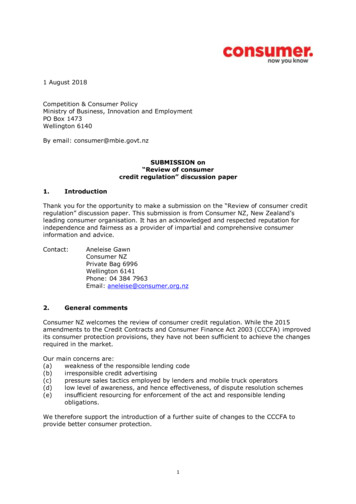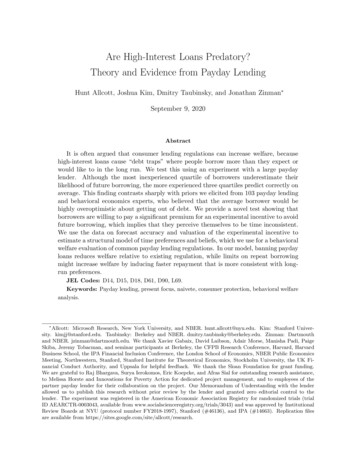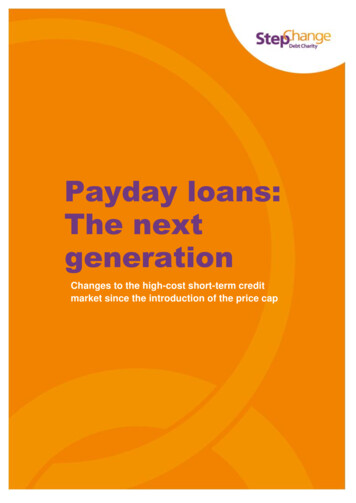
Transcription
Payday loans:The nextgenerationChanges to the high-cost short-term creditmarket since the introduction of the price cap1
Executive SummaryThe payday loan market grew rapidly in the years following the financial crisis. Millions offamilies faced stretched incomes and tighter restrictions on mainstream credit leaving manyto turn to high cost credit like payday loans. However, poor lending practices, productfeatures and the high cost of these loans resulted in many people getting into severefinancial difficulties. Unprecedented numbers of people came to debt advice organisationswith payday loan debts. At StepChange Debt Charity we saw year on year increasesculminating in 82% more people coming to us with payday loan debts in 2013 than in 2012.Widespread concerns about these products and the practices of the lenders led to muchneeded action. In 2015 the FCA brought in stricter rules on payday lending including limitson rolling over loans, stronger affordability guidance and financial health warnings, and aprice cap on high cost short-term credit (HCSTC).This report looks at changes in the market since these changes were brought in.Definition of payday loansPayday loans are relatively small sums lent over a short period of time at a highinterest rate. They were previously lent for around 30 days but can now be mediumterm instalment loans of two months to a year. This research covers both these loantypes using the FCA definition of ‘high-cost short-term credit’: any regulated creditagreement that has an APR equal to or exceeding 100% and is provided for amaximum of 12 months and is not a doorstep loan, bill of sale loan or overdraft. Thisreport looks at products included in this FCA definition and refers to them as high-costshort-term credit (HCSTC) and HCSTC lenders. For ease of understanding for ourrespondents we used payday loans in the questions in our survey of clients.Evidence suggests that the 2015 FCA regulation has made a difference. StepChange DebtCharity has seen significantly fewer clients coming to us with HCSTC debts 16% of ourclients had HCSTC debts in the first half of 2016 compared to nearly a quarter (23%) in2013. This suggests fewer people are getting these loans and less of those who take outHCSTC are struggling to repay.However, the HCSTC market has changed and adapted to the post price cap landscape.The market has broadened to encompass different forms of loans that, unlike the ‘traditional’30 day payday loan, are repaid over two months to a year. Giving customers a longer periodto repay and breaking up repayments into smaller chunks can be beneficial, but it can alsomean interest builds up over a longer period making borrowing more expensive overall.The report finds some welcome signs of improvement on some of the worst conduct issuesseen at the peak of the market in 2013. This included widespread irresponsible lending and2
aggressive debt collection practices. We have seen less of lenders making excessive use ofcontinuous payment authorities (CPAs) leaving borrowers with nothing in their account andsending threatening and misleading letters to customers.However, there are still issues with lending practices. Over a third of our clients with HCSTCdebts have three or more such debts and three quarters of clients in our survey tell us thatthey got a HCSTC loan when they already had outstanding HCSTC. There is also evidenceof issues with affordability assessments as a quarter of our clients said that they did notknow or only had a rough idea of how much they would have to repay. Furthermore, justover a quarter said they did not think the lender took reasonable steps to assess their abilityto repay a HCSTC loan.There were also issues with how HCSTC lenders treat customers in financial difficulties. Oursurvey found that after telling the lender they were struggling to repay, less than half of ourclients were told about free debt advice and only just over a quarter had an affordablerepayment plan agreed. Moreover, just under a quarter of clients found the lender continuedto demand payment even when told about the client’s financial difficulties, one in five foundtheir lender continued to add interest and charges and just over one in ten were threatenedwith court or other enforcement action.The FCA’s review of the impact of the price cap to be completed in 2017 should look furtherinto continuing problems with poor lending practices and poor treatment of customers infinancial difficulties and take action where necessary.In bringing in the price cap the FCA estimated that around 160,000 people a year would nolonger have access to HCTSC loans.1 This raised the question of where people turn whenthey are no longer able to access a HCSTC loan. Our research looked at clients whoapplied for HCSTC, had previously been accepted but since the price cap had beenrejected. We looked at where these people turned after they could not get a HCSTC loan.Some borrowed from other lenders, including other HCSTC providers, their credit card,overdraft or home credit loans. Many missed an essential bill or another loan payment orborrowed from friends and family. These households are facing seriously constrainedchoices between taking out high cost credit, missing a household bill payment or not havingenough money to pay for essentials like feeding their family. This confirms that as ourresearch has previously shown, certain households are struggling to get by withoutborrowing or getting into arrears, and there is still a significant gap in the market foraccessible, affordable credit.2This report highlights issues in the HCSTC market two years on from the price cap and thepackage of tougher rules. It puts forward recommendations for the FCA to look at as part oftheir review of the price cap. It also recommends that the government look to improveaccess to affordable alternatives to high cost credit for the most financially vulnerablehouseholds.3
Key recommendations:1. The FCA should explore as part of their review of the price cap, what theimplications of the shift to instalment loans are for the appropriate level ofthe price cap.2. The FCA should strengthen their rules on responsible lending includingturning their existing guidance on responsible lending into rules. Forexample, creditworthiness assessments should be required to takeaccount of whether the customer is experiencing difficulties with theirexisting financial commitments.3. The FCA price cap review should have a broad scope to include thecontinuing issues with the treatment of customers in arrears and how totackle them.4. HCSTC lenders should ensure that their debt collection practices arebased on supporting affordable and sustainable repayments and providingappropriate support to help customers in financial difficulties.5. The FCA should ensure consistency of regulation across differentforms of high cost and mainstream credit to deal with the problemsfinancially vulnerable consumers’ experience. This would include forexample, setting a cap on unarranged overdraft charges.6. The government needs to look at new ways to provide greater access tomore affordable credit safety nets for the most financially vulnerable,including looking at international examples of no and low interest loanschemes.4
IntroductionPayday lending is still a relatively new sector with most lenders only entering the market in the UKover the past decade.3 However, the payday loan market grew rapidly, particularly following thefinancial crisis of 2008, and peaked around 2013.4 The Financial Conduct Authority (FCA) foundthat in 2013, 10 million loans were taken about by 1.6 million consumers, with a total value of 2.5billion.5 Payday loans had become a household name and a dominant player in the high cost creditmarket in the UK.The difficulties many consumers faced with payday loans during that period of rapid growth arewell documented with the Office of Fair Trading (OFT) finding that widespread irresponsiblelending led to too many people being granted loans that they could not afford to repay.6 Highinterest and charges, rollovers and repeat borrowing meant that many struggling borrowers foundtheir payday loan debts spiralled out of control. The consequence of this was that debt adviceagencies saw a flood of people coming to them with problems with payday loans. At StepChangeDebt Charity, we saw a series of year-on-year increases culminating in 82% more people comingto us with payday loan debts in 2013 than in 2012 (36,413 people in 2012 to 66,557 people in2013).7The FCA took over regulation of consumer credit in April 2014 and identified HCSTC as a high riskmarket. Providers came under scrutiny when they applied for full authorisation, and a number ofrules were brought in to address particular practices. The new rules included strengthenedaffordability checks, signposting to debt advice, financial health warnings and limiting the numberof times loans can be ‘rolled over’. In late 2013 the Government directed the FCA to cap the priceof payday loans, and the cap came in on 1 January 2015. The price cap includes three caps.Interest on the loan must not exceed 0.8% per day of the amount borrowed; there is a cap ondefault charges of 15; and the total price cap means a borrower should never have to repay morethan 100% of the amount borrowed.There is good reason to believe that the actions of the FCA have gone some way to tackling theworst excesses of the HCSTC market. This is welcome progress. But problems remain and theFCA has committed to reviewing the impact of the price cap in the first half of 2017.8 This briefingaims to feed into this review by exploring how better regulation and the price cap have had animpact on the HCSTC market by looking at the experiences of StepChange Debt Charity clientswith HCSTC. It also explores what more could be done to ensure this type of lending could workbetter for borrowers and what alternative forms of more affordable credit are needed for those thatare more financially vulnerable.5
MethodologyTo explore how the HCSTC market has changed since the introduction of moreeffective regulation, we reviewed the existing literature on this and conducted anumber of research projects with our clients: Data analysis on StepChange Debt Charity clients with HCSTC: Wecompared clients with HCSTC debts who came to us in the first half of2013 (January to June 2013) with clients with HCSTC debts who came tous in the first half of 2016 (January to June 2016). We looked at theirdemographic profile, household type, income, employment and housingstatus etc. We also compared the clients with HCSTC in H1 2013 with allour clients in H1 2016 to explore how those with HCSTC are different tothe general profile of people in problem debt. Data analysis on HCSTC debts: We compared HCSTC debts recordedwith StepChange Debt Charity in March 2013 with the HCSTC debtsrecorded with us in January 2016, in order to explore how the HCSTCmarket has changed from its peak in 2013. Review of today’s HCSTC products: We undertook some analysis ofthe ten HCSTC lenders that StepChange Debt Charity clients had themost debts with in H1 2016. Survey of clients: We conducted a survey of StepChange Debt Charityclients to find out their experiences of using HCSTC and where they wentif they were not able to access HCSTC. The sample was StepChangeDebt Charity clients who came to the charity for advice between 20152016 and had all applied for HCSTC after January 2015. We had 530respondents between 1 August and 14 August 2016.6
Changes in HCSTCHCSTC debt make-up of StepChange Debt Charity clients haschangedSince the FCA took over consumer credit regulation, some HCSTC lenders have chosen to leavethe market and others have gone into liquidation. Citizens Advice has estimated that 38% of thefirms operating in 2013 have exited the market.9 Other reports state that more than 1,400 paydaylending companies have left the industry since summer 2014 and significantly fewer loans arebeing made by the companies left in the market with 6.3 million loans granted in the first half of2013 and 1.8 million in the first half of 2015.10 The Consumer Finance Association (CFA), a shortterm lending trade association, also reported lending in March 2015 was down 68% from March2013 levels.11Evidence from StepChange Debt Charity clients reflects the broader trends of a contraction of theHCSTC market. We have seen a significant fall in the number of people coming to us with HCSTCdebts. 23% of our clients advised in the first half of 2013 had HCSTC and this had fallen to 16% ofclients advised in the first half of 2016. The average total amount owed on HCSTC by clients hasalso fallen from 1,647 in 2013 to 1,308 in 2016.12 This all indicates that the FCA price cap andnew rules on HCSTC lending have made a difference as it suggests fewer people are beinggranted HCSTC that they cannot afford to repay. Therefore substantially lower numbers ofborrowers are getting into difficulties and having to turn to debt advice agencies like StepChangeDebt Charity.Proportion of StepChange Debt Charity clients with HCSTC 10.0%5.0%0.0%H1 20132013 (full year) 2014 (full year) 2015 (full year)H1 2016Comparing the ten lenders StepChange Debt Charity saw the most HCSTC debts with in 2016with the number of debts we saw with those lenders in 2013 shows changes in loan product typesin the debts we see. The chart below illustrates that many of the more dominant players in theHCSTC market in 2013 who at that time solely provided the ‘traditional’ 30 day payday loanproduct had the highest debt levels in our 2013 data. These have seen significant reductions for7
example, HCSTC lender 1 constituted nearly a quarter (23%) of all the HCSTC debts we sawwhereas in 2016 it made up just 9%.In contrast, newer entrants to the HCSTC market offering medium term loans (2 months to a year)repaid in instalments, are making up more of the HCSTC debts we see. The chart below showsthat two lenders offering only instalment loans have seen a significant increase in the number ofHCSTC debts recorded by StepChange Debt Charity. These lenders (HCSTC lender 25 and 26)were only established after 2012 so made up zero or less than 1% of the debts we saw in 2013 butare now some of the lenders that StepChange Debt Charity sees the most HCSTC lending debtswith. This suggests that although product types in the HCSTC sector have changed, this does notmean problem debts are no longer caused by the new ‘improved’ medium-term loan product. Thesection below discusses the impact of new instalment loans in more detail.25%23%20%15%10%9%12%10%11%9%6%11%8%7%4%5%3% 4%5%4% 5%0%0%5%0%0%HCSTClender 1HCSTClender 2HCSTClender 3HCSTClender 4HCSTClender 8Proportion of debts 2013HCSTCHCSTCHCSTCHCSTCHCSTClender 9 lender 11 lender 25 lender 26 lender 27Proportion of debts 2016How the HCSTC product has changedTo explore how the HCSTC market has changed, we looked at the ten HCSTC lenders who ourclients had the most debts with. This made up 74% of all our clients’ HCSTC debts in the first halfof 2016.Alignment to the price capAll HCSTC lenders now have to price within the regulatory cap. Our review of the ten HCSTClenders our clients had the most debts with found that they had all charged at the price cap. Theyhad similar representative APR of between about 1200-1600% and of those that stated it on theirwebsite all had a daily rate of 0.8%. The exception was one lender who offered only medium termloans (of between 6-12 months) so had a lower representative APR. All of the lenders that chargefor missed payments (three out of the ten did not charge late payment fees) have the capped levelof default charges at 15. This suggests there is limited evidence of prices falling below the pricecap levels.8
A move to instalment loansA major change since the introduction of the price cap has been a move from products requiring asingle repayment within 30 days to loans able to be repaid in instalments over 2 to 12 months. TheFCA HCSTC research in 2013 found that the market at that time was dominated by short term,small sum loans with the average loan at around 260 and lent over an initial duration of 30days.13 The CFA has stated the sector has adapted to regulatory changes by offering slightlylarger loans over a period of months rather than days.14 It is argued that it is no longercommercially viable to offer only a very short term loan and there have been suggestions that the‘30 day loan product’ is now used as a loss leader to attract new customers to other products.15Looking at the product offerings of the ten most common HCSTC lenders among our clients’ debtswe found that nearly all of them offered loans between 50- 1,000 (for first time borrowers). Themajority (six out of the ten) now offer instalment loans alongside the traditional one month loanproduct with four lenders only offering the medium term instalment loan option. Some of theHCSTC lenders offering instalment loans are providing slightly different product features, such asoffering no missed payment fees, not doing rollovers and offering weekly repayments instead ofmonthly.The findings from our survey also could be reflecting the move to instalment loans with moremedium term repayment periods and loans for slightly larger amounts. In our survey the averageamount borrowed was 411 with 34% borrowing 200 or less, 29% borrowing between 200- 400and 18% borrowing between 400- 600. In total over half (53%) of clients had a repayment termof 3 to 6 months, with 27% of clients having to repay within a month, 24% were borrowing for 3months, and 23% for 6 months.How long was the repayment term on your loan?1 month or less2%11%2 months27%3 months23%4 months7%2%4%24%5 months6 months9
There are benefits to this shift to longer-term instalment loans as having the repayment spread outand not requiring repayment in a single lump sum should help prevent HCSTC creating acutepayment difficulties for households. One of the problems with the one month payday loan was thatpeople were finding that 28-30 days was not long enough to find the funds to cover therepayments and also meet their essential costs for that month. If they were unable to repay in thattime, they could be forced to borrow again and the build-up of interest and charges could lead todebts spiralling out of control. If payment was missed they faced default charges, if they rolledover their loan they were also hit by charges and further interest, and if another loan was taken outto cover other expenses they faced further interest. Therefore having a longer period to repay theloan could help borrowers avoid these debt traps.However, there are issues with instalment loans and they are still expensive credit products.Borrowers may end up paying more for an instalment loan than they would with a payday loanafter making the payments in full as high interest rates are applied to the amount borrowed over alonger period. For example, if you were to borrow 200 from one HCSTC lender with a repaymentperiod of 30 days it would cost around 250 to repay whereas if you were to borrow the sameamount with monthly repayments over three months it would cost nearly 300 and if you were toborrow over six months it would cost nearly 350. The FCA review should look at whether thecurrent level of the price cap is suitable if applied to medium-term loans.The suggested benefit of instalment loans is that they are easier to repay and do not lead to thesame extreme debt spiral. These more manageable instalment repayments are expected to lead tofewer missed payments so fewer default charges, fewer rollovers and less repeat borrowing. Thequestion is whether these new products have led to less detriment in reality. The greater use ofmore manageable instalment loans could play a role in the significant reductions in people comingto debt advice charities with payday loan problems. Nonetheless, we have seen clients who stillstruggle with the repayments and high interest with instalment loans. In our survey, clients told usabout struggling to repay instalment loans and about their issues with repaying loans even with theprice cap:“Trying never to get one [a HCSTC loan] again as I pay 237 per month for 6months and I only borrowed 800 so paying back nearly double what I borrowed.”StepChange Debt Charity client with HCSTC debts“I can't have this kind of stress again no more. I am paying them double paymentfrom how much I took off them so it’s actually no worth it taking from them.”StepChange Debt Charity client with HCSTC debtsThe FCA should explore as part of their review of the price cap, what the implications of theshift to instalment loans are for the appropriate level of the price cap.10
Who are our clients with HCSTC debts in 2016?Compared to our clients in general, those with HCSTC debts are more likely tobe under 25, employed full-time, in a household without children, and living inrented accommodation. They are also more likely to have essential bill arrearsthan our clients in general: Younger: nearly a quarter (24%) of clients with HCSTC debts are under25 whereas only 14% of clients in general are in this age group.Employed full time: Significantly more of those with HCSTC debts areemployed full-time than our clients in general (48% to 30%). There arealso fewer clients with HCSTC debts who are unemployed than clients ingeneral (22% to 30%)Renters: Clients with HCSTC debts are significantly more likely to berenters than homeowners (90% are renters compared with 77% of allclients). They are more likely to be renting privately (43%) than in socialhousing (25%).Family composition: There are fewer clients with HCSTC debts that arein families made up of a couple with children than clients in general (22%to 26%). They are more likely to be single without children (46% to 38%).Essential bill arrears: Clients with HCSTC debts are more likely to haveessential bill arrears: 15% of clients had HCSTC debts and rent arrearswhereas 13% of all clients had rent arrears. 24% of clients had HCSTCdebts and Council Tax arrears whereas 20% of all clients had CouncilTax arrears. 24% of clients had HCSTC debts and utility (water,electricity and gas bill) arrears whereas 22% of all clients had utilityarrears.There is little change in the demographic and socio-economic profile of clientswith HCSTC debts between 2013 and 2016. They are broadly the same in ageand family composition, employment status and income band. There are smallchanges suggesting clients with HCSTC debts in 2016 are slightly less likely tobe in the most financially vulnerable groups. For example, clients with HCSTCdebts in 2016 are less likely to be on very low incomes (below 10,000 a year)than those in 2013 (25% in 2013 to 19% in 2016). They are also slightly lesslikely to be unemployed as 26% were unemployed in 2013 and 22% areunemployed in 2016. However, our evidence suggests that despite changes tothe market, people with HCSTC debts are still very likely to display significantfinancial vulnerability.11
HCSTC: Lending practicesContinued problems with lending practicesOur evidence suggests that there have been some improvements but there are still causes forconcern about lending practices and inadequate assessments of affordability among HCSTClenders. The survey asked clients how well they understood how much they would have to repaywhen they took out a HCSTC. The majority (73%) knew exactly, or had a good idea of, how muchthey would have to repay with some clients commenting:“I felt information was clearer on interest rates and being told what the final amountwould be if I repaid earlier.”“The amounts repayable [were] clearly set out.”StepChange Debt Charity clients with HCSTC debtsHowever, it is still concerning that in total a quarter (25%) said that they did not know or only had arough idea of how much they would have to repay. As one client said:“It wasn't explained to me that I would need to pay back 650.”StepChange Debt Charity client with HCSTC debtsThere could be various reasons why some clients have reported not understanding how much theywould have to repay. There are requirements on lenders to provide borrowers with pre contractualinformation on the credit agreement including the total price that will have to be repaid (in theConsumer Credit Act 1974, section 55A).16 Also FCA rules (CONC 4.2) require adequate precontract explanation to enable the borrower to understand whether they can afford to repay thecredit. It may be that in some cases lenders are not complying with these requirements as thequote above suggests. It could also be that the information provided is not clear enough and isdifficult for borrowers to understand.When you took out the loan, how well did you understand how much you would have torepay in total?I did not know how much I would have to repay6%I had a rough idea how much I would have torepay19%I had a good idea how much I would have torepay22%I knew exactly how much I would have to repay50%0%10%20%30%40%50%60%12
When asked whether the HCSTC lender they used had taken reasonable steps to assess theirability to repay the loan (see examples in chart below), the majority (74%) thought they had.Nonetheless just over a quarter (26%) did not think the lender took reasonable steps with somecommenting:“I found that all pay day loan companies do not check correctly if you can makerepayments. This made it easy to get in to a bad situation and made me feelanxious and depressed.”“The fact you can get this credit with minimal checks is shameful.”“Checks were carried out at time of first application for a loan, after that they'll justhand out loans whenever you ask for one as long as previous loan has been paidoff.”StepChange Debt Charity clients with HCSTC debtsDo you think the lender took reasonable steps to assess your ability to repay the loan?Yes – the lender asked me questions about yourpersonal finance and general situation26%46%Yes – the lender ask me to send documents aboutyour personal finances and general situationYes – the lender did a credit check of your creditscore24%4%NoSome clients also told us they were able to get a HCSTC loan when they had considerable otherdebts, raising more questions about responsible lending and the adequacy of affordability checks:“I should have not been lent the amount as I already had a huge amount of credit torepay to other creditors.”“I was in a lot of debt anyway and the payday loan tipped me over the edge.”“I already had 6 loans out and rejected by 100 more but they still accepted me.”StepChange Debt Charity clients with HCSTC debtsWe also continue to see a high proportion of StepChange Debt Charity clients with multipleHCSTC debts. In 2016 over a third (38%) of our clients with HCSTC debt had three or more.13
Additionally nearly a quarter (23%) have four or more and 14% have five or more. The chart belowshows there has been some changes since 2013, as more clients now have just one HCSTC debt( 12%) and slightly fewer have 5 or more HCSTC debts (-6%). Despite these small changes, thereis still a concern that so many of our clients are still coming to us in 2016 with multiple HCSTCdebts.Proportion of clients with one of more HCSTC debts50%45%40%35%30%25%20%15%10%5%0%40%32%22% 22%15% 14%14%11%12201321%320169%45 Our client survey also found that the majority of respondents had a HCSTC loan that they werepaying off when they took out another HCST loan as the chart below shows:25%YesNo75%Some of clients described how they were able to access a HCSTC loan when they already hadoutstanding HCSTC:“I had multiple loans out with them and other lenders.”“Considering I already had 11 other payday loans, I am surmising little/no checkswere done.”StepChange Debt Charity clients with HCSTC debts14
In summary, our evidence suggests that some borrowers still do not fully understand how muchthey have to repay and some do not think the HCSTC lender took reasonable steps to assess theirability to repay. Moreover, some people are still able to get HCSTC when they already haveconsiderable other debts, including other HCSTC debts. This all suggests that the FCA should lookcloser at responsible lending measures in this market.The FCA strengthened their rules around affordability assessments for HCSTC in 2014 andworked to encourage lenders to share data in real-time in order to identify up-to-date data onoutstanding credit commitments. However, they have acknowledged that there are still issues withthis as not all lenders report data to one or more credit reference agencies in real time and there isno standard definition of what constitutes real-time data sharing.17 The FCA have said that this isan area that they are monitoring closely. However, the significant number of clients with multipleHCSTC debts suggests that the FCA could go further and look again at the case for mandating asystem of real-time data sharing. However, this may not be any more effective if lenders are stilllending when they know potential borrowers have considerable other debts.In introducing the price cap, the FCA stated that they would be keeping certain aspects of theHCSTC market under review, including the adequacy of affordability assessments.18 There arecontinued issues around lending practices with borrowers with considerable existing commitmentsable to get HCSTC loans and multiple HCSTC debts. This suggests lenders could be doing morecomprehensive creditworthiness assessments and that the FCA needs to look again at lendingpractices. The FCA Consumer Credit sourcebook (CONC) includes a section on responsiblelending (CONC 5) with rules. However some of this is only guidance, for example, it is currentlyonly guidance that lenders should take into account whether a customer is experiencing difficultieswith their existing financial commitments.The FCA should strengthen thei
5 Payday lending is still a relatively new sector with most lenders only entering the market in the UK over the past decade.3 However, the payday loan market grew rapidly, particularly following the financial crisis of 2008, and peaked around 2013.4 The Financial Conduct Authority (FCA) found that in 2013, 10 million loans were taken about by 1.6 million consumers, with a total value of 2.5



